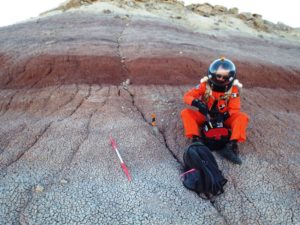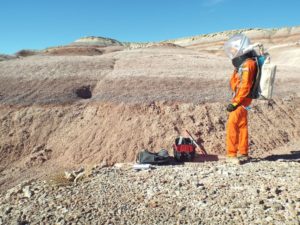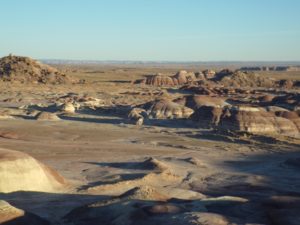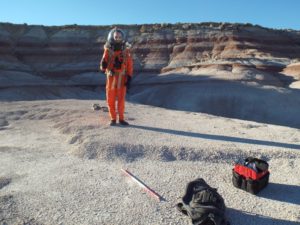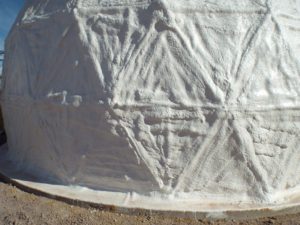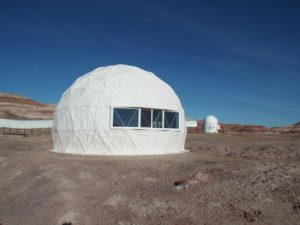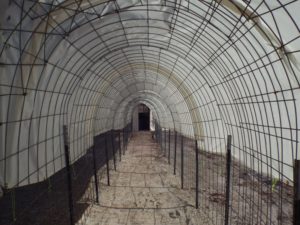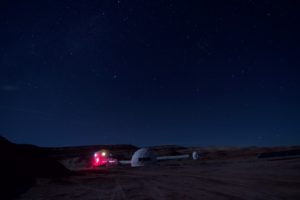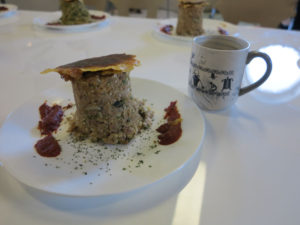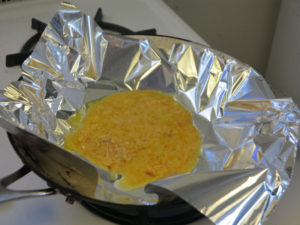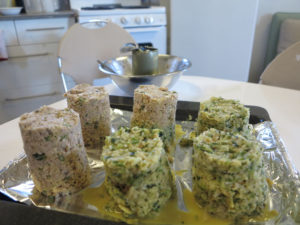
Archive: 11 Nov 2016
Crew Photos – November 11th
EVA Narrative – November 11th
DATA GATHERING
Jon Clarke
My last two EVAs have been focussed on collecting geological data. Nothing as exciting as testing and falsifying hypotheses (in your face Karl Popper!). Just the painstaking collecting of samples that will provide new data from which new ideas, even new hypotheses, may emerge. Much geological work is of this type – geophysical and geochemical surveying, lithostratigraphic and biostratigraphic work all being examples.
Multi-coloured sediments of the Morrison Formation at MDRS (Google Earth image)
In this case we are collecting soil samples of every colour change through the Brushy Basin Member of the Morrison Formation from just behind the station to the top of “Hab Ridge”. These colourful beds are a distinctive part of the local landscape. The samples will be sent to the University of Arkansas for geochemical and mineralogical analysis by one of our absent crew members, Paul Knightly. He will be joining us in the second half of the Mars 160 mission on Devon Island. In the mean time Paul is providing geological support for the rest of the team.
Sampling on the steeper parts of “Hab Ridge”
What will the data show? We don’t know. The colour changes are likely to reflect changing conditions during deposition and immediately post-deposition of the Brushy Basin Member. Examples include mineralogy, sediment type, sedimentation rate, degree of water logging, and volcanic ash inputs. We hope to see a pattern in the mineralogy and geochemistry that will help us discover these changes and processes. The data can also be used to ground truth remotely sensed data, such as from the ASTER sensor on the Japanese-US Terra and Aqua satellites.
The point of it all – an array of samples ready to be sent off for analysis
Similar changes in chemistry and mineralogy are likely to explain some of the cyclic sediments we see on Mars. Understanding how to read and interpret such patterns in remotely sensed data where we have ground truth will increase our ability to interpret similar patterns on Mars where we mostly do not have found truth. We are pushing back the frontiers of science, one sample and one step at a time.
Science Post – November 11th
The Science Dome
By Anushree Srivastava – Crew Biologist
To my great delight, I would like to let you all know that our Science Dome is operational now. For me, it is like a new home on the “Mars” where I am going to spend my time with our Crew Geologist Dr Jon Clarke and my other crew members who are being cross-trained into the science operations of Mars 160 mission. Dr Clarke and I would be performing the geological and microbiological, in other words, astrobiological experiments, inside the dome.
The white dome situated amid the reddish plateaus and stunning Mars-like landscape is the new feature of Mars Desert Research Station. The dome is connected to our habitat and observatory by surface tunnels. So we walk through the tunnels to reach the dome without space suits and thus not exposed to the harsh “Martian” environment. The dome is made of Styrofoam which is expandable and cost-effective and the crisscross pattern on its rough outer surface looks exotic and quite Martian! In the left side of the dome there is a power station and on the right side, we have laboratory shelves and equipment. The dome has a window that provides you the glimpses of beautiful “Martian” landscape, and in turn keeps you inspired to embark on the venture of human exploration of Mars. And surprisingly, sometimes when I hum in the dome my crew mates can hear me because it echoes J
Figure 1 a, b and c: Science Dome from outside. Image Credit: Dr Jon Clarke
Figure 2: Tunnel connecting dome with the habitat. Image Credit: Dr Jon Clarke
Figure 3: The hab and science dome in the night. Image Credit: Dr Alexandre
The dome is equipped with standard laboratory facilities and it is going to host advanced equipment and technologies to facilitate in-depth astrobiological study in a simulated Martian environment. Here the Mars Society’s long-term Martian simulation mission stands out because it principally focuses on the science operations, both inside the science laboratory and on the field during intense EVAs in coordination with human factors research. Under the auspices of Mars 160 mission the three principal science projects, which are lichen biodiversity, hypolith abundance and molecular analysis, as well as the exploration of ancient evaporites from astro-geo-microbiological perspective. Planned geoscience work will consist of soil moisture content by gravimetric analysis and measuring both soil electrical conductivity and pH by the 1:5 method. The lab will also provide a convenient working space to preserve samples in order to send them back to our Earth-based science team situated at NASA Ames Research Centre and Canadian Museum of Nature in Ottowa.
Sol Summary – November 11th
Sol Summary Report (SSR):
Sol# 48
Person filling out report: Annalea Beattie
Summary Title: Yes, its Friday, the Expanse, omelet rice and pineapple upside-down cake!
Mission Status: on track
Sol Activity Summary:
We began the day with the internet down (so we switched it off) and a bit more cleaning up this morning. This is the life everywhere, there is no escape from cleaning.
Rishu, (Anushree) and I washed all the glass science equipment and stored it. Alex worked on his suit interface. I answered some questions about our Mars 160 mission for some school children on a word doc. Yusuke continued the food inventory in preparation for the Arctic, (Phase Two of our mission). Jon wrote reports, Anastasiya wrote reports, Claude- Michel wrote reports and cooked lunch. The EVA team left and returned, ate lunch then prepared to leave again and left. Claude-Michel continued with the food report, the engineering report, the smartpot report and his log. Anu processed samples. Yusuke was Hab-Com for the away team, worked on his own dome project and cooked omelet rice for dinner. This afternoon I had a great few hours work in my room, planning field drawing experiments in the space suit for the next week and writing up my notes, Then I cooked a pineapple-upside down cake which turned out pretty well, surprising. Yes! The Expanse is tonight.
MDRS lessons:
- Make sure you have enough rest otherwise your body will kick you back badly.
(Anastasiya)
- Colour changes that are obvious in Google Earth imagery are not so obvious on the ground. (Jon)
Plans: EVA – Hypoliths quadrats tomorrow
Crew Physical Status: Much improved.
Weather: Nice day.
Anomalies: Back pack failure on EVA and return to base.
Space suits have to be learnt the hard way. Today our geology crew returned early from an EVA after the charge in a back pack failed half up Hab Ridge. One crew member was very hot by the time we removed the space suit. This is an anomaly, the second time this has happened this mission which is probably statistically very good.
I didn’t but you probably know that early space suits had just compressed oxygen bottles so air was cooled (sometimes very cold ) when it came out. The suits were cooled only by oxygen air flow like ours. Current technology uses an inner suit as a cooling garment. Little tubes carrying water go everywhere around the body. The water passes through a sublimater which freezes liquid to ice and then the ice sublimes and cools the circulating tubes of water. It still sounds pretty basic to me but how would I know? Anyhow, anomaly sorted and the EVA continued this afternoon.
Recipe for Tower of Awesomeness
Food Report for 11 of November 2016.
Tower of Awesomeness: (for guest that aren’t afraid of height, culinary vertigo)
Ingredients:
meat tower
2 can of pink salmon/ 5 persons
1 Cup of dehydrate onions / 5 persons
2 portions of powdered eggs / 5 persons
1 and half cup of dehydrated cheese / 5 persons
A handful of crystallize lemon
A handful of parsley
A handful thyme leaves
Veggie Tower
2 Cups of dehydrated cabbage
Half a cup of dehydrated onions
Half a cup of dehydrated celery
1 portion of powdered eggs
1 cup of dehydrated cheese
A handful of old spices
sides
2 cans of tomato paste
A handful of chili powder
a few flakes of Habanero powder (be careful this stuff is lethal)
A handful of parsley powder
Some olive oil
Enough water (so it your wish consistency)
Note: For all the ingredient in handful quantity, you don’t have to put the same quantity just as much as you want or to your taste.
For this recipe you will need a empty can of whatever. We used a can of pink salmon with the ripped bottom to help us to push the tower out of it with out making a mess.
400
Making the can holder:
Step MtCH – 1 : Take a can in the shape you want your tower to have. I suggest a can of salmon as the radius is pretty good for the height.
Step MtCH – 2 : With a can opener or a knife (be careful with knifes they cut and are dangerous, ask you parent first for help (even if you are 40+, you can never be too careful)
Step MtCH – 3 : For now on this can will be called «tower maker».
Step MtCH – 4 : This step isn’t really about making the tower maker but still, pre-heat the oven at 400 Celcius.
Meat tower
Step MT – 1 : Hydrate well all the dehydrated ingredients in water.
Step MT – 2 : Mix all the ingredients under the meat tower section in a mixing bowl and mix them well.
Step MT – 3 : Fill the tower maker with the mix until is it full, pushed everything tightly inside the can, the denser the better it will hold. Make sure the bottom of the can is on a clean and solid surface, else everything you put in will fall (remember you opened the bottom earlier)
Step MT – 4 : Turn the tower maker upside down in a pan that can go in the oven.
Veggy Tower
Step VT – 1 : Hydrate all the dehydrated vegetables.
Step VT – 2 : Mix all the ingredients in a mixing bowl and mix well. Very important, you don’t want all the habanero powder in the same bite.
Step VT – 3: Fill the tower maker with the veggy mix until it is full. If you do both type of towers, you will notice this one is by far juicier and doesn’t hold as well. If you made a second lower tower maker it willl be perfect for this one. Else it will still hold, but the tower will look shorter and fatter since it will collapse a little bit on itself without breaking.
Step VT – 4: Turn the tower maker upside down on a plate that can go in the oven.
Cooking the towers
Step CtT – 1 : Once all your pans look like downtown New York (filled with towers) or that you ran out of mixture, put the pans in the preheated oven.
Step CtT – 2: I am sorry for the anyone that wished to have a timer on how long they will need to stay in the oven while you do something else. Tough luck, you probably read this step after making all the other, you will need to watch them cook and verify once in a while to see if they are ready to eat. It should take around two hours. They are very dense and you don’t want to have an uncooked middle tower.
Preparing the Sides
Step PtS – 1 : Mix all the ingredients in a pan and mix well.
Step PtS – 2: Remember that habanero powder are very very very strong, a few flake will be enough. To measure in mg more than anything else.
Step PtS – 3: There is actually two side preparation the other one is a secret for only those who get this far in the preparation. All you need to do is to melt some cheese in a pan and let it get crispy, like almost burn a little.
Step PtS – 4: To finish the Tower all you need to do once they are well cook is to take a slice a crispy cheese and put it on the top of the tower and serve some of the sauce on the side of the dish. That is all you are done now.
Step PtS – 5: I almost forgot, serve to everyone that is patiently waiting to eat. If people are silent while eating its because they like it. Also if the silence make you nervous you can talk about how you discover this recipe and talk about Mars. Enjoy.
Sol Journal – November 11th
Laundry on Mars or Robert Zubrin’s invention
How often do you need to do the laundry on Mars? If you have to choose no bacteria and smell or no stains on your clothes, what would you choose?
Smelly clothes, no water, no soap but happy crew. How could this be possible? Thanks to president of Mars Society Robert Zubrin. He invented a special machine, which can kill all the bacteria in clothes and therefore the smell of sweat.
Four of the crew members arrived in Denver and visited Zubrin’s company Pioneer Astronautics. It was a cozy office with Mars Colonization posters hanging on the walls. Suddenly a beautiful spaniel dog came out. “Kepler, welcomes you!” – said Robert with a smile, appearing from the CEO room. Kepler follows Robert to work every day. As we continued the excursion of the office, more and more it was obvious that here is where creative engineering lives. Before entering an engineering and construction laboratory, we put on protective glasses. Pipes, tanks of different liquids and gas, metal parts and much more than I can describe. Robert asked an employee if the machine was ready for us. Transparent plastic cylinder, where the clothes should be placed covered by the lid with pipe. The pipe connected to vacuum pump, which just requires electricity to work.
The mechanism of this unique machine is simple. It creates low pressure, less than 1/30th of an atmosphere in cylinder with dirty clothes. The water inside the bacterial cell boils, eventually breaks down the cell wall and deprived of its water, the bacteria dies. The sweat and oil that our body produces also evaporates. Since there is no water and chemicals to dissolves the stains, Martians will have clothes with no trace of the sweat but with spots. Luckily, astronauts do not care so much about the flawless look of their clothes.
We tested vacuum laundry machine at Robert’s office and after he gave us the “Go”, we packed it into our car and head off to Mars Desert Research Station. It has been almost two months since we began to use our unusual washing machine. We put our dirty clothes into cylinder or vacuum chamber, cover it with the lid, switch on the vacuum pump for 2 hours, and leave the chamber closed for an hour after. Then take out the clothes and smell it. Magic, socks do not smell at all!
I hope this prototype is just a first generation of vacuum laundry machine industry on Mars and in solar system. What a brilliant idea to use resources of space – the vacuum. No need to waste the precious water, to carry cleaning chemicals, all you need is to use the vacuum outside of your spaceship!






